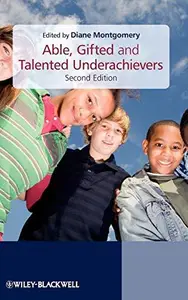
Free Download Able, Gifted and Talented Underachievers By Diane Montgomery (ed.)
2009 | 360 Pages | ISBN: 0470740973 | PDF | 3 MB
A practical guide to identifying gifted underachievers and enabling them to fulfil their potential, raising whole school standards. Extensive new content includes the latest best practice in addressing able underachievement Explains the origins of underachievement, both overt and covert, especially in more able learners - provides a model that identifies a range of factors that conspire to lower achievement The UK Government's 2005 White Paper 'Higher Standards, Better Schools for All' set specific provision for Gifted and Talented (G&T) - there are similar programmes in all developed countries The editor is a leading researcher in G&T education - contributors include Belle Wallace, Barry Hymer and Ian Warwick, the foremost practitioners in the field Content: Chapter 1 Why Do the Gifted and Talented Underachieve? How Can Masked and Hidden Talents Be Revealed? (pages 1-40): Diane MontgomeryChapter 2 Literacy, Flexible Thinking and Underachievement (pages 41-57): Joan FreemanChapter 3 What do We Mean by an 'Enabling Curriculum' That Raises Achievement for All Learners?: An Examination of the TASC Problem?Solving Framework: Thinking Actively in a Social Context (pages 59-84): Belle WallaceChapter 4 How Can Inclusive and Inclusional Understandings of Gifts/Talents Be Developed Educationally? (pages 85-110): Jack Whitehead and Marie HuxtableChapter 5 Effective Teaching and Learning to Combat Underachievement (pages 111-154): Diane MontgomeryChapter 6 Changing the Teaching for the Underachieving Able Child: The Ruyton School Experience (pages 155-182): Lee Wills and John MunroChapter 7 Understanding and Overcoming Underachievement in Women and Girls ? A Reprise (pages 183-199): Carrie WinstanleyChapter 8 Understanding and Overcoming Underachievement in Boys (pages 201-218): Barry HymerChapter 9 Improving the Quality of Identification, Provision and Support for Gifted and Talented Learners from Under?Represented Communities Through Partnership Working (pages 219-263): Ian WarwickChapter 10 Gifted and Talented Children with Special Educational Needs ? Underachievement in Dual and Multiple Exceptionality (pages 265-301): Diane MontgomeryChapter 11 Using Assistive Technologies to Address the Written Expression Needs of the Twice?exceptional Student (pages 303-325): William F. Morrison, Tara Jeffs and Mary G. RizzaChapter 12 Case Studies of Three Schools Tackling Underachievement (pages 327-343): Diane Montgomery
